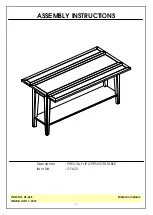
Height Adjustment
Two screws, located at the top and bottom of the hinge, mount the hinge
to the cabinet. Turn these first to make sure the door is secure. If the
door is still too high or low, loosen these screws slightly and then lift or
lower the door until it is in the position you want. Firmly tighten the
screws to secure the door. Remember to support the door as you
loosen these screws or it could drop completely out of its initial position.
Close the cabinet doors to see whether the fit is satisfactory. Repeat the
process if adjustment is still needed.
Depth Adjustment
The screw closest to the back of the cabinet is the depth screw and
moves the doors in and out. Use this screw to adjust how far out or in
the doors are in comparison to your cabinet and to the other cabinet
doors and drawers surrounding it. Loosen the screw and manually push
or pull the door to adjust it to the position you want. Firmly tighten the
screws to secure the door. Close the cabinet doors to see whether the
fit is satisfactory. Repeat the process if adjustment is still needed. If
possible, avoid maxing out the adjusting screw for it may cause
unwanted problems.
Side-To-Side Adjustment
The screw closest to the cabinet door allows the doors to move from
side to side. Tighten this screw (clockwise) to move this corner of the
door further toward the frame; loosen it (counterclockwise) to move the
door away from the frame. This adjustment can also be used to correct
a door that is not hanging straight. If the top is further to the left or right
than the bottom, adjust the top and bottom hinges separately to correct
the tilt. Close the cabinet doors to see whether the fit is satisfactory.
Repeat the process if adjustment is still needed. If possible, avoid
maxing out the adjusting screw for it may cause unwanted problems.
HINGE ADJUSTMENT
Page 10 of 10




























